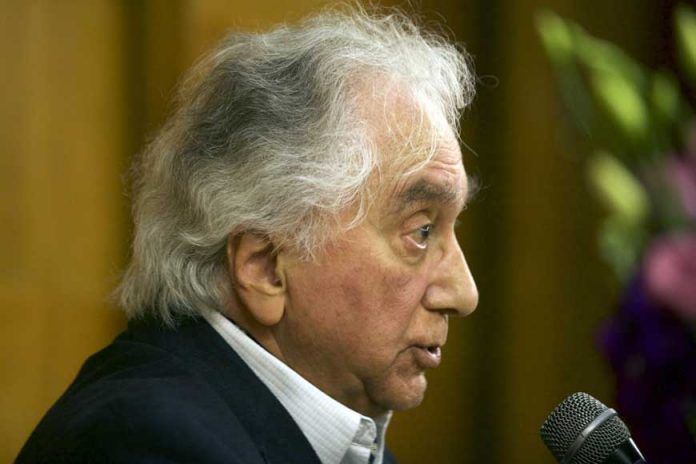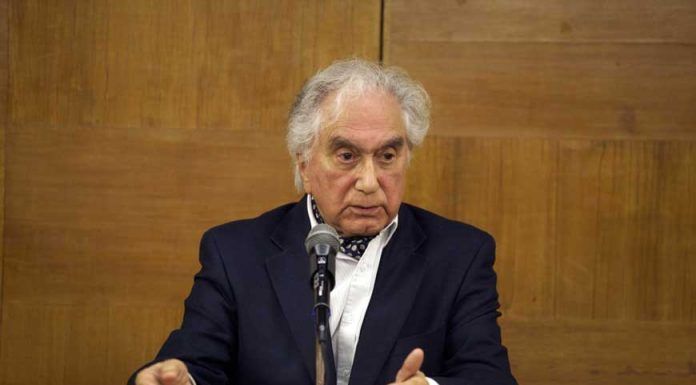By Kayhan Life Staff
The celebrated Iranian composer and music professor Hormoz Farhat died on Aug. 16 in Dublin at the age of 93.
Professor Farhat had left Iran after the Revolution and lived in Dublin for most of his life.
Hormoz Farhat was born in 1928 in Tehran. He was the first Iranian artist to study music at the University of California, Los Angeles (UCLA), where he received a bachelor’s degree in music in 1953.
Mr. Farhat then got a master’s degree in composition from Mills College in Oakland, California, and wrote his thesis in composition — which included a piece he had written, “sinfonia concertante” — under the tutelage of the renowned French composer Darius Milhaud.
Farhat continued his music studies in the U.S. and received a Ph.D. in composition and ethnomusicology from UCLA in 1956, writing his dissertation on dastgah, a musical modal system in traditional Persian music.
As part of his field research and music studies, Farhat interviewed several masters of Iranian music in the 1950s, including Hossein Saba (a virtuoso of the santur, a classical Persian instrument) and Nasrollah Zarinpanjeh (a virtuoso of the setar).
The Cambridge University Press published Farhat’s research titled “The Dastgah Concept in Persian Music” in 1990. It is one of the most authoritative works written in English on Persian music, and was translated into Farsi by Mehdi Pour-Mohammad and published in Iran by Part Press in 2002.
Farhat also published several books and articles, including a semi-autobiographical account “Present Past: Notes from the Life of a Persian-American Composer,” published in Farsi and translated into English in 2019.
After teaching at UCLA for several years, Farhat returned to Iran in 1968 to continue his research, focusing on “ta’zieh,” a religious passion play based on the death of the third Shia Imam, Hussein ibn-Ali (626-680 AD).
Farhat was supported in his research by the Ministry of Culture and by Iran’s first Minister of Culture, Mehrdad Pahlbod. Mr. Pahlbod and the ministry recruited filmmakers and sound engineers to help Farhat record and document performances of ta’zieh in various regions in Iran.
“Not to boast, but my research in ta’zieh has revived it as a traditional [form of] Iranian theater,” Professor Farhat said of the project.
Shah’s Brother-in-Law Mehrdad Pahlbod Is Remembered in Memoir
After completing his research, Farhat stayed in Iran for several more years and served as a professor and dean of the Music Department at Tehran University from 1970 to 1978. He was also the director of the Music Council at National Iranian Radio and Television network from 1969 to 1978.
Farhat always spoke fondly of Reza Ghotbi (1940-), who at the time headed National Iranian Radio and Television.
Farhat moved to Ireland in 1979. He was the professor and the chair of the School of Music in Trinity College Dublin from 1982 to 1995. He retired in 1995 but continued to work with Trinity College as a professor emeritus.
During his long academic career, Farhat taught at many universities in Europe and the U.S., including two terms at Harvard University in 1972 and 1973.
Professor Farhat’s musical works include “Mazandarani” (a rhapsody for orchestra), “Three Songs of Sa’adi” (for soprano and orchestra), Sinfonia Concertante (for seven solo instruments, soprano, and orchestra), and several piano quintets, string quartets and flute concertos.
Farhat’s works have been performed in many countries, including Iran, Britain, Romania, France, Poland, Ireland, the Philippines, and the U.S.
Farhat also collaborated with several Iranian directors, writing music scores for their films — including Farrokh Ghaffari’s “South of the City” (1958), Nasser Taghvaei’s “Tranquility in the Presence of Others” (1973), and Dariush Mehrjui’s “The Cow” (1969), “Mr. Naive” (1971), and “The Postman” (1973).
Professor Farhat is survived by his wife Maria Baghramian, a professor of American Philosophy at the University College Dublin, and their son.
[aesop_image img=”https://kayhanlife.com/wp-content/uploads/2021/08/Hormoz-Farhat_3-768×576-1.jpg” panorama=”off” credit=”Hormoz Farhat with his wife. Kayhan London.” align=”center” lightbox=”off” captionsrc=”custom” captionposition=”left” revealfx=”off” overlay_revealfx=”off”]




